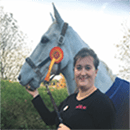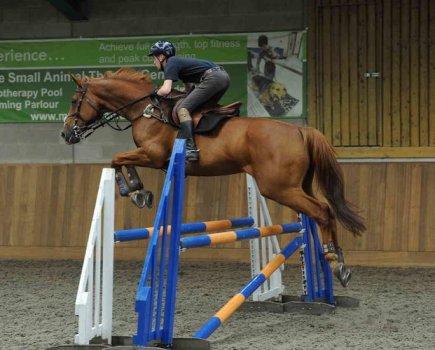If you enjoy jumping, at some point you will have experienced your horse chipping in a stride before they take off for a fence. Perhaps you weren’t on a great stride and so your clever horse is solving the problem for you — or maybe you felt there was nothing wrong with the stride at all, but your horse disagreed.
According to FEI and British Showjumping accredited coach Leanne Heslop, there are a few things that need to be looked at in this situation and it is all focused on one thing: improving the quality of the canter.
“A good showjumping canter needs to have a good rhythm and tempo, with a stride that is even and correct in length,” she explains.
Why do horses ‘chip’ in?
Lack of canter rhythm or energy
According to Leanne, a horse will tend to chip in an extra stride if the rider isn’t in a rhythm or hasn’t seen a distance and so starts to change the rhythm or energy of the canter by pulling or kicking on the approach.
“Instead of interfering if you can’t see the distance, stay the same,” she advises. “Remain balanced, support the horse between your hand and leg and let them sort it out.”
Rider’s eyeline is too low
The other thing to remember is to keep your eyes up.
“One of the most frequent errors I come across when coaching is riders staring at the base of the jump on the approach, especially if there is a filler,” says Leanne.
“Your horse follows your eyeline, so if you’re looking down into the jump, that’s where you are positioning the horse.
“Your head is the heaviest part of your body and if you’re looking down, your shoulders will tilt, your chest will come forward and your horse
will probably be on the forehand.”
When this happens, it makes it harder for the horse to get off the ground, and so they’re inclined to put in an extra ‘stuffy’ stride.
“Instead, I encourage riders to put their eye line above the jump, or at least on the top pole of the fence,” adds Leanne.
“Upon take off you need to look at where you want to be going next.”
Try these exercises
Leanne uses the following three exercises to develop a horse’s canter at home. After warming up, give these a go — you can do one per session, or mix it up, depending on how your horse is finding it.
1, Find the right stride length
“This exercise will encourage a better stride length with good ground coverage and will also help to hone the rider’s eye for a stride,” says Leanne.
“The aim is to ride three equal strides between the two poles.”
How to set it up
Place two poles 42ft (12.8m) apart on the long side of your arena or schooling field.
How to ride it
- In canter, come around to ride over the poles. Focus on riding a straight line on your approach to the fence and during the getaway. Don’t cut corners.
- Try to ride the same canter between the poles as before and after. Don’t mess about in between. The aim is to establish a regular, even stride and continue to ride this.
- If your horse is fitting more than three strides between the poles you need to think about riding a bigger canter that covers more ground per stride. This doesn’t mean going faster.
- Once you have developed the canter and your horse is covering more ground to reach the take-off point for the second pole on an even three strides on both reins, make this pole into a cavaletti (or a small upright).
- Don’t change the canter just because you now have a fence instead of a pole. You are keeping it small to help build your horse’s confidence jumping from this stride.
- If this is going well, change the first pole into a cavaletti, too. Again, don’t change anything about the canter. Establish a rhythm before the first cavaletti and ride positively to give your horse the confidence to jump from this stride length.
The next step
If you and your horse are ready, make the distance slightly longer and raise the cavaletti into small verticals.
“Allow for a generous ground line in front of the fences, especially as they get bigger, as this will help you to develop your eye for a better take-off spot,” advises Leanne.
“It will also give you a feel for the level of energy and ground cover you need in the canter so that your horse has the confidence to take off and not get too close.”
2, Maintain the canter
“This exercise will help you learn to maintain the canter and stay in a consistent rhythm while creating engagement and bend,” explains Leanne.
“In turn, this will also improve the quality of the canter and suppleness through the horse’s back.”
How to set it up
Set out four poles on a 20m circle at 12, 3, 6 and 9 o’clock. This will usually give three strides between each pole, but you can make the circle bigger or smaller depending on the horse you are riding.
How to ride it
- In canter, come onto the circle of poles and find the point where you can ride three strides between each pole.
- Aim for a consistent rhythm and tempo, landing with each canter pole in the middle of your horse’s stride.
- Once the horse has the hang of this, try playing around with the line. Come on the inside curve and ride two strides, or move to the outside curve and ride four. As you do this, focus on maintaining the same rhythm and tempo.
- If this is going well, raise alternate poles, or all four, up into cavaletti. Remember that this isn’t about height — it’s about establishing a good quality canter.
3, Ditch the ‘chip in’
“This exercise is helpful for riders who have a good quality canter and rhythm on the approach, but who find that their horse chips in despite this,” says Leanne.
“Most horses who chip in an extra stride land in a heap after jumping with all the activity taken out of the canter. This will impact the next fence as the landing and getaway sort out the approach to the next jump, and the approach sorts out the landing and the getaway.”
How to set it up
Put up a vertical fence at a height you are comfortable with but one which won’t overface the horse. Place a ground pole 18-21ft (5.5-6m) in front of the fence. Place a second one 30-33ft (9-10m) after the jump.
How to ride it
- Approach in canter, focusing on riding a consistent rhythm to the pole. Because of the pole’s positioning you will know that you have one stride to the jump, so you can get used to judging the take-off point.
- After the jump, you need to continue riding to reach the second pole. This pole will encourage you to ride forward after the fence. Doing this will get you into the habit of reacting upon landing to sort out the canter for the approach to the next jump.
Leanne Heslop is a BHSII, BS and FEI accredited coach based in North Yorkshire who has been training horses and riders for over 25 years. She specialises in coaching showjumpers and training young performance horses.
Main image (stock) © Your Horse Library/Sally Newcomb








